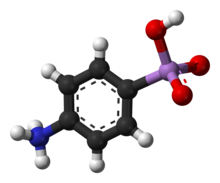History
Roots and synthesis
Since at least 2000 BC, arsenic and inorganic arsenical compounds were both medicine and poison. [11] [12] In the 19th century, inorganic arsenicals became the preeminent medicines, for instance Fowler's solution, against diverse diseases. [11]
In 1859, in France, while developing aniline dyes, [13] Antoine Béchamp synthesized a chemical that he identified, if incorrectly, as arsenic acid anilide. [14] Also biologist, physician, and pharmacist, Béchamp reported it 40 to 50 times less toxic as a drug than arsenic acid, and named it Atoxyl, [14] the first organic arsenical drug. [1]
Medical influence
In 1905, in Britain, H W Thomas and A Breinl reported successful treatment of trypanosomiasis in animals by Atoxyl, and recommended high doses, given continuously, for human trypanosomiasis (sleeping sickness). [13] By 1907, more successful and less toxic than inorganic arsenicals, Atoxyl was expected to greatly aid expansion of British colonization of Africa and stem loss of cattle in Africa and India. [13] (So socioeconomically valuable was colonial medicine [15] that in 1922, German company Bayer offered to reveal the formula of Bayer 205—developed in 1917 and showing success on sleeping sickness in British and Belgian Africa—to the British government for return of German colonies lost via World War I.) [14] [16]
Soon, however, Robert Koch found through an Atoxyl trial in German East Africa that some 2% of patients were blinded via atrophy of the optic nerve. [14] In Germany, Paul Ehrlich inferred Béchamp's report of Atoxyl's structure incorrect, and Ehrlich with his chief organic chemist Alfred Bertheim found its correct structure [13] —aminophenyl arsenic acid [17] or aminophenyl arsonic acid [14] —which suggested possible derivatives. [14] [17] Ehrlich asked Bertheim to synthesize two types of Atoxyl derivatives: arsenoxides and arsenobenzenes. [14]
Ehrlich and Bertheim's 606th arsenobenzene, synthesized in 1907, was arsphenamine, found ineffective against trypanosomes, but found in 1909 by Ehrlich and bacteriologist Sahachiro Hata effective against the microorganism involved in syphilis, a disease roughly equivalent then to today's AIDS. [17] The company Farbwerke Hoechst marketed arsphenamine as the drug Salvarsan, "the arsenic that saves". [14] Its specificity of action fit Ehrlich's silver bullet or magic bullet paradigm of treatment, [11] and Ehrlich won international fame while Salvarsan's success—the first particularly effective syphilis treatment—established the chemotherapy enterprise. [17] [18] In the late 1940s, Salvarsan was replaced in most regions by penicillin, yet organic arsenicals remained in use for trypanosomiasis. [11]
Contemporary usage
Arsanilic acid gained use as a feed additive for poultry and swine to promote growth and prevent or treat dysentery. [2] [3] [4] For poultry and swine, arsanilic acid was among four arsenical veterinary drugs, along with carbarsone, nitarsone, roxarsone, approved by the U.S. Food and Drug Administration (FDA). [19] In 2013, the FDA denied petitions by the Center for Food Safety and by the Institute for Agriculture and Trade Policy seeking revocation of approvals of the arsenical animal drugs, but the drugs' sponsors voluntarily requested the FDA to withdraw approvals of three, including arsanilic acid, leaving only nitarsone approved. [5] In 2015, the FDA withdrew nitarsone's approval. [20]
Arsanilic acid is still used in the laboratory, for instance in recent modification of nanoparticles. [6]
It is a reagent for the detection of nitrite in urinalysis dipsticks.

An antibiotic is a type of antimicrobial substance active against bacteria. It is the most important type of antibacterial agent for fighting bacterial infections, and antibiotic medications are widely used in the treatment and prevention of such infections. They may either kill or inhibit the growth of bacteria. A limited number of antibiotics also possess antiprotozoal activity. Antibiotics are not effective against viruses such as the common cold or influenza; drugs which inhibit growth of viruses are termed antiviral drugs or antivirals rather than antibiotics. They are also not effective against fungi; drugs which inhibit growth of fungi are called antifungal drugs.

Paul Ehrlich was a Nobel Prize-winning German physician and scientist who worked in the fields of hematology, immunology, and antimicrobial chemotherapy. Among his foremost achievements were finding a cure for syphilis in 1909 and inventing the precursor technique to Gram staining bacteria. The methods he developed for staining tissue made it possible to distinguish between different types of blood cells, which led to the ability to diagnose numerous blood diseases.

Arsphenamine, also known as Salvarsan or compound 606, is a drug that was introduced at the beginning of the 1910s as the first effective treatment for syphilis, relapsing fever, and African trypanosomiasis. This organoarsenic compound was the first modern antimicrobial agent.
Fowler's solution is a solution containing 1% potassium arsenite (KAsO2), and was once prescribed as a remedy or a tonic. Thomas Fowler (1736–1801) of Stafford, England, proposed the solution in 1786 as a substitute for a patent medicine, "tasteless ague drop". From 1865, Fowler's solution was a leukemia treatment.
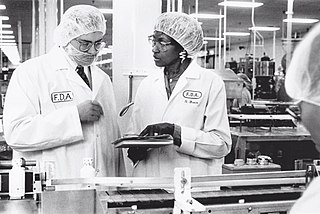
The pharmaceutical industry discovers, develops, produces, and markets pharmaceutical drugs for the use as medications to be administered to patients, with the aim to cure and prevent diseases, or alleviate symptoms. Pharmaceutical companies may deal in generic or brand medications and medical devices. They are subject to a variety of laws and regulations that govern the patenting, testing, safety, efficacy using drug testing and marketing of drugs. The global pharmaceuticals market produced treatments worth $1,228.45 billion in 2020 and showed a compound annual growth rate (CAGR) of 1.8%.

Neosalvarsan is a synthetic chemotherapeutic that is an organoarsenic compound. It became available in 1912 and superseded the more toxic and less water-soluble salvarsan as an effective treatment for syphilis. Because both of these arsenicals carried considerable risk of side effects, they were replaced for this indication by penicillin in the 1940s.

Trypanosoma brucei is a species of parasitic kinetoplastid belonging to the genus Trypanosoma that is present in sub-Saharan Africa. Unlike other protozoan parasites that normally infect blood and tissue cells, it is exclusively extracellular and inhabits the blood plasma and body fluids. It causes deadly vector-borne diseases: African trypanosomiasis or sleeping sickness in humans, and animal trypanosomiasis or nagana in cattle and horses. It is a species complex grouped into three subspecies: T. b. brucei, T. b. gambiense and T. b. rhodesiense. The first is a parasite of non-human mammals and causes nagana, while the latter two are zoonotic infecting both humans and animals and cause African trypanosomiasis.
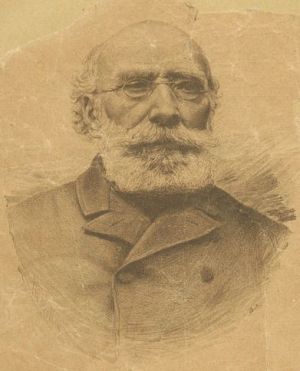
Pierre Jacques Antoine Béchamp was a French scientist now best known for breakthroughs in applied organic chemistry and for a bitter rivalry with Louis Pasteur.

Sahachirō Hata was a prominent Japanese bacteriologist who researched the bubonic plague under Kitasato Shibasaburō and assisted in developing the Arsphenamine drug in 1909 in the laboratory of Paul Ehrlich.
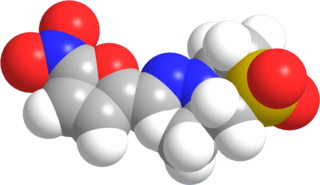
Nifurtimox, sold under the brand name Lampit, is a medication used to treat Chagas disease and sleeping sickness. For sleeping sickness it is used together with eflornithine in nifurtimox-eflornithine combination treatment. In Chagas disease it is a second-line option to benznidazole. It is given by mouth.
In organic synthesis the Béchamp reaction is used for producing arsonic acids from activated aromatic substrates. The reaction is an electrophilic aromatic substitution, using arsenic acid as the electrophile. The reaction proceeds according to this idealized stoichiometry for the preparation of arsanilic acid:
Organoarsenic chemistry is the chemistry of compounds containing a chemical bond between arsenic and carbon. A few organoarsenic compounds, also called "organoarsenicals," are produced industrially with uses as insecticides, herbicides, and fungicides. In general these applications are declining in step with growing concerns about their impact on the environment and human health. The parent compounds are arsane and arsenic acid. Despite their toxicity, organoarsenic biomolecules are well known.
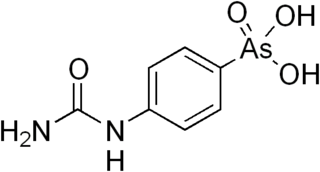
Carbarsone is an organoarsenic compound used as an antiprotozoal drug for treatment of amebiasis and other infections. It was available for amebiasis in the United States as late as 1991. Thereafter, it remained available as a turkey feed additive for increasing weight gain and controlling histomoniasis.
Pharmaceutical engineering is a branch of engineering focused on discovering, formulating, and manufacturing medication, analytical and quality control processes, and on designing, building, and improving manufacturing sites that produce drugs. It utilizes the fields of chemical engineering, biomedical engineering, pharmaceutical sciences, and industrial engineering.
Fexinidazole is a medication used to treat African trypanosomiasis caused by Trypanosoma brucei gambiense. It is effective against both first and second stage disease. Some evidence also supports its use in Chagas disease. It is taken by mouth.

Nitarsone is an organoarsenic compound that is used in poultry production as a feed additive to increase weight gain, improve feed efficiency, and prevent histomoniasis. It is marketed as Histostat by Zoetis.
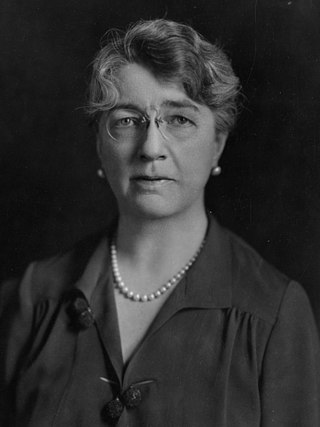
Louise Pearce was an American pathologist at the Rockefeller Institute who helped develop a treatment for African sleeping sickness (trypanosomiasis). Sleeping sickness was a fatal epidemic which had devastated areas of Africa, killing two-thirds of the population of the Uganda protectorate between 1900 and 1906 alone. With chemists Walter Abraham Jacobs and Michael Heidelberger and pathologist Wade Hampton Brown, Pearce worked to develop and test arsenic-based drugs for its treatment. In 1920, Louise Pearce traveled to the Belgian Congo where she designed and carried out a drug testing protocol for human trials to establish tryparsamide's safety, effectiveness, and optimum dosage. Tryparsamide proved successful in combating the fatal epidemic, curing 80% of cases.
Harold Wolferstan Thomas (1875–1931) was a Canadian medical doctor, noted for his research in the field of tropical medicine.
The magic bullet is a scientific concept developed by a German Nobel laureate Paul Ehrlich in 1907. While working at the Institute of Experimental Therapy, Ehrlich formed an idea that it could be possible to kill specific microbes, which cause diseases in the body, without harming the body itself. He named the hypothetical agent as Zauberkugel, and used the English translation "magic bullet" in The Harben Lectures at London. The name itself is a reference to an old German myth about a bullet that cannot miss its target. Ehrlich had in mind Carl Maria von Weber's popular 1821 opera Der Freischütz, in which a young hunter is required to hit an impossible target in order to marry his bride.

Arsonic acids are a subset of organoarsenic compounds defined as oxyacids where a pentavalent arsenic atom is bonded to two hydroxyl groups, a third oxygen atom, and an organic substituent. The salts/conjugate bases of arsonic acids are called arsonates. Like all arsenic-containing compounds, arsonic acids are toxic and carcinogenic to humans.

